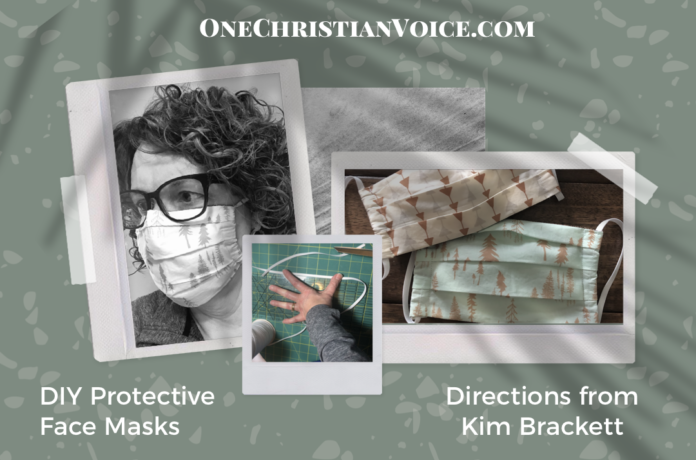Homeschooling mom and former Superintendent of Christian Education, Kim Brackett, started making protective masks after learning that a shortage of masks was putting healthcare workers at risk for the Coronavirus. She started making a few for some close friends and when word got out, she couldn’t keep up with the demand.
Handmade creations for her beloved grands have been put on hold while she churns out these little masks that are almost as effective as surgical masks. According to Smart Air Filters, the masks are 95% effective against hazardous particles as opposed to medical supply surgical masks, which are 97% effective.

A police officer contacted Kim desperately seeking ten masks for his shift. Kim explained to him that she was not selling them, only donating. He and his partner then wanted to donate to her cause, to which she responded, “You can leave a cup of coffee from Moka coffee shop on my porch when your partner picks up his masks if you’d like,” and he, of course, obliged.
Generosity in this little town of North Aurora, Illinois just seems to compound. Shortly after the call from the police officer came in, a nurse posted on Facebook a request for face masks, and a friend of Kim’s tagged her. When the nurse asked how much the masks were, and Kim told her they were free, this nurse insisted on paying her. Kim suggested more coffee from Moka’s, in an effort to support them during these tough economic times. When the nurse came to retrieve her masks, she had not only brought some piping fresh Moka’s coffee, but also some supplies for the masks and a $20 gift card for more Moka coffee!
As requests for the masks continued to pour in, Kim searched for a way to increase production, starting with a Facebook post with video instructions on making the masks. The video, however, was not easy understand, even for a seasoned seamstress, like herself.
Kim said, “People are desperate and grateful. I found people willing to sew them. One family is ready to make 100 masks, but the information floating around is so confusing. I searched and researched and practiced and I’m ready to recommend a method and supplies.”
Here is the method Kim recommends:
How to Make Protective Masks
- For the front of the mask, cut one piece of fabric 9″ x 7.5″ and for the back, cut two pieces 7¾” x 3″.

2. Fold down the long edge of both pieces of backing fabric to make a ⅜”hem, sew seam in place and press.


3. Pleat the front layer with approximately three 1″ pleats so that the finished pleated front layer measures 4.25″ in length.

4. Sew the backing fabric to the front fabric, right sides together, with 1″ of front fabric extending on each side.

5. Press seams open.
6. Flip your whole mask over. The next step is to press the back pieces both towards the center. The top and bottom will overlap.
7. To form a casing, on each end, fold the pleated front edge under. Press and fold under again so that the raw edge does not show. Pin, press and sew.

8. Cut two pieces of elastic 10½” each.
9. Using a safety pin, feed the elastic through the tunnel and pin the ends of the elastic together to form a loop.

10. Cut the vacuum cleaner bag filter shown in the image, approximately 6″ in width and about 5¼” length. If you cannot find vacuum cleaner bag filter, you can use one of the other materials in the list above. Just be aware they are less effective that the vacuum cleaner bags. Remove the vacuum cleaner filter before washing the face mask, and replace it with a new filter before using again.

10. Pull elastic through so that seams where the elastic was joined are on the inside of the casing.
Making handmade products is so much more than just filling a basic need. The time and creativity that you put into to this surgical product, sends a warm message to the people out there on the front line, telling them, “Thank you. I care about your health too.”
If you have made one of these masks, please share the love and show us your handmade face masks by posting it in the comments section of this article.







